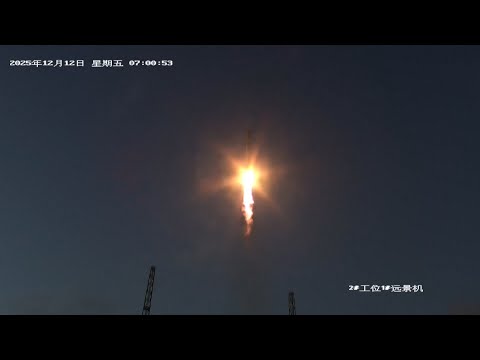Now Reading: Dcubed to demonstrate in-space manufacturing of solar arrays
-
01
Dcubed to demonstrate in-space manufacturing of solar arrays
Dcubed to demonstrate in-space manufacturing of solar arrays


BREMEN, Germany — German satellite component company Dcubed is moving into in-space manufacturing with a series of missions to demonstrate production of large solar arrays in orbit.
The company announced at Space Tech Expo Europe on Nov. 18 its ARAQYS product line, which will provide the ability to manufacture solar arrays in orbit with more flexibility and at lower cost than traditional arrays.
A key test of that technology will take place on a mission called ARAQYS-D3, scheduled to launch in the first quarter of 2027 on a SpaceX rideshare mission arranged by Maverick Space Systems and using a satellite bus from Astro Digital. That mission will manufacture a solar array capable of generating two kilowatts of power.
The spacecraft will carry a blanket of rolled-up solar cells. “We unroll it in space and print a structure on it that stiffens it,” Thomas Sinn, chief executive of Dcubed, said in an interview. That structure uses a resin cured by ultraviolet light, which he said offers a low-power method of producing it.
Printing the array structure in space is less complex for large arrays than manufacturing them on the ground. “The traditional approach with folded panels gets very heavy,” he said, requiring thicker panels and larger release mechanisms designed to survive the launch environment.
“The big advance of this in-space manufactured solar array is that it is designed for use in space. We don’t need any hinges or hold-down release mechanisms. So, we can make it very thin up there,” he added.
Dcubed also plans to use terrestrial solar cells instead of space-qualified ones. Sinn said doing so can reduce costs from hundreds of dollars per watt to “double-digit” dollars per watt, an important factor for emerging power-intensive applications like space data centers. Terrestrial cells should be sufficient for satellites with lifetimes of about five years.
“We are really going with this for the megaconstellations, for the cheap satellites,” he said. “It’s not something we would use for the space station or anything like that.”
ARAQYS-D3 is an ESPA-class spacecraft about one meter on a side. When fully deployed, the solar array will extend about 15 meters. Sinn said Dcubed has worked closely with Astro Digital, whose Colorado headquarters is located a few miles from Dcubed’s U.S. office.
Dcubed plans two precursor missions ahead of ARAQYS-D3. The first, ARAQYS-D1 or Dcubed-1, is a 3U cubesat built to demonstrate production of a 60-centimeter boom in space. ARAQYS-D2 will test the printing of a one-meter solar array as a payload on a spacevan mission by French company Exotrail. Both are scheduled to launch on separate SpaceX rideshare missions in early 2026.
Dcubed also builds traditional solar arrays and recently won a contract from Intuitive Machines to supply arrays for the first in a series of lunar communications satellites. Sinn said two kilowatts was the break point where in-space manufactured (ISM) arrays made sense.
“We could see that a lot of the customers that we have right now that need two kilowatts or higher could replace their traditional solar array with an ISM solar array, because they can save an order of magnitude in cost,” he said.
Dcubed is seeking initial customers for its ISM solar array, including the U.S. Space Force and the German military. One potential application is power beaming, which Sinn said the company plans to attempt to demonstrate on ARAQYS-D3.
There is theoretically no limit to how large an array could be produced with this technology. “We go now with two kilowatts because that is the right balance between doable and completely crazy,” he said. The next steps would be five-kilowatt arrays, followed by 10- to 20-kilowatt versions.
Large arrays create structural challenges for spacecraft that must maneuver frequently. However, he said, “if you don’t need to do a lot with the spacecraft, you could go to 100 meters, one kilometer.”
The name ARAQYS is derived from aranea, the Latin word for spider. “They can make very nice structures when needed,” Sinn said. It is also a play on Arrakis, the world from the “Dune” series of novels and movies. “I loved the movie,” he said.
Stay Informed With the Latest & Most Important News
Previous Post
Next Post
-
 012024 in Review: Highlights from NASA in Silicon Valley
012024 in Review: Highlights from NASA in Silicon Valley -
 02Panasonic Leica Summilux DG 15mm f/1.7 ASPH review
02Panasonic Leica Summilux DG 15mm f/1.7 ASPH review -
 03From Polymerization-Enabled Folding and Assembly to Chemical Evolution: Key Processes for Emergence of Functional Polymers in the Origin of Life
03From Polymerization-Enabled Folding and Assembly to Chemical Evolution: Key Processes for Emergence of Functional Polymers in the Origin of Life -
 04How New NASA, India Earth Satellite NISAR Will See Earth
04How New NASA, India Earth Satellite NISAR Will See Earth -
 05And Thus Begins A New Year For Life On Earth
05And Thus Begins A New Year For Life On Earth -
 06Astronomy Activation Ambassadors: A New Era
06Astronomy Activation Ambassadors: A New Era -
07SpaceX launch surge helps set new global launch record in 2024



















